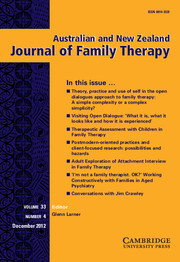Article contents
Stages of Change Theory in Family Therapy for Sibling Sexual Assault
Published online by Cambridge University Press: 02 March 2012
Abstract
Family therapy understands the benefits of therapeutically supported dialogue amongst family members when there are challenging themes and topics that need to be discussed. This paper is an attempt to explore ways that family therapists can work with family members who are thrust into therapy rather than ‘voluntarily’ signing up for it. It applies ideas from the drug and alcohol field such as Stages of Change theory and Motivational Interviewing. The paper explores how these ideas and approaches might help family therapists to formulate a concept of resistance and to make helpful dialogue more likely. They are applied to families experiencing sibling sexual assault, where they become involved with a legal response that necessitates a therapeutic intervention.
- Type
- Articles
- Information
- Australian and New Zealand Journal of Family Therapy , Volume 32 , Issue 4 , December 2011 , pp. 343 - 356
- Copyright
- Copyright © Cambridge University Press 2011
References
- 2
- Cited by




